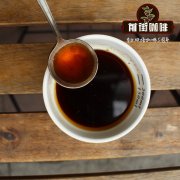What is the honey treatment of coffee beans? What is coffee honey treatment?

Professional coffee knowledge exchange more coffee bean information please follow the coffee workshop (Wechat official account cafe_style)
The coffee beans we use when making coffee are actually the seeds inside the coffee fruit. In the outer layer of the seed, there are exocarp, pulp, pectin, endocarp and silver peel and other structures, and the purpose of processing is to remove these external structures in order to obtain internal coffee seeds.
Honey treatment rises and water-saving taste is changeable.
Reviewing the three major treatment methods of coffee-sun, water washing and honey treatment, it can be said that the most traditional method is to dry the pulp directly, and then remove the pulp; the washing method is the most stable, the coffee fruit is first pressed open by the machine, and the coffee fruit with flesh will be put into the water to remove the pulp, ferment, wash and dry.
Honey treatment between sun exposure and water washing has become more and more popular in recent years. Not only because the taste is popular with consumers, the bigger reason is that honey treatment can reduce the use of water, and the manor can make more coffee flavor through different degrees of honey treatment. At present, most coffee beans in Costa Rica are treated with honey.
Honey treatment refers to peeling off part of the pulp of the coffee fruit, retaining the pectin layer and exposing it to the sun. The acidity of honey-treated coffee beans is lower than that of water washing, and the fruit flavor is stronger, while the color of honey-treated coffee beans is from light to dark, which is divided into white, yellow, red, black and other colors because of the degree of peeling and exposure of the pulp. The deeper the color, the deeper the degree of fermentation, the higher the sweetness.
Honey treatment does not mean wrapping a layer of honey on the coffee beans! The "honey" here refers to the mucous layer of coffee pulp. After harvest, coffee cherries peel off the outer pericarp with a peel machine, leaving the pulp after the sun, so that the sweetness of the pulp can enter into the beans, and it does not have to take as long as the sun method, which is a popular treatment at present.
The production process of honey treatment is complex and laborious. If it is not properly controlled, the whole batch of beans will have the smell of overripe fermentation, but if they are well done, the coffee beans will have a relatively high sense of sweetness. The advantage of honey treatment is that it can reduce the acidity of beans, and the aroma is more meticulous, but this is the taste when the honey treatment is carried out perfectly. If it is not carried out well, it will taste bad acetic acid, like onions or garlic. Even if it is carried out quite well, it will still have a little muddy smell, the aftertaste is not clean, and the miscellaneous smell will be heavier than the general water washing method. Therefore, on the whole, the risk of honey treatment is much higher than that of general wet treatment.
Important Notice :
前街咖啡 FrontStreet Coffee has moved to new addredd:
FrontStreet Coffee Address: 315,Donghua East Road,GuangZhou
Tel:020 38364473
- Prev

The difference between Honey treatment, Solar treatment and Water washing Coffee beans are treated with honey and added sugar
Professional coffee knowledge exchange more coffee bean information Please pay attention to the coffee workshop (Wechat official account cafe_style) the most common coffee treatments are tanning, washing and honey treatment, although I often hear these treatments, but what's the difference? Please take out your notebook and take good notes. Natural: this is the most traditional and simplest
- Next

SCA barista training, a little abnormal intermediate barista examination questions, the coefficient of difficulty is high!
Today's article, I would like to share with you some of the exam questions I sorted out on the Internet, the difficulty is in the intermediate barista, the content is a bit long, so divided into the upper and lower episodes ~ ~ I hope you can read it carefully ~ ! 1. The correct manners of the female barista is (D). A, raised legs B, bow head to play with mobile phone C, hands on waist D, waist back straight editor interpretation: send sub-questions. two
Related
- What is the meaning of lactic acid fermentation with coffee bean treatment?
- How to judge the state of foam by sound?
- How does the latte pull out the unicorn pattern? Come to get for a little trick to improve the flower pull!
- Will flower pulling affect the taste of the latte?
- Do you know the history of coffee?
- The difference between honey treatment and sun washing what is raisin honey treatment?
- What kind of milk can a novice use to make coffee foam to keep the foam longer? The correct method and skills of milking tutorial sharing
- Why do washed coffee beans taste sour? Flavor characteristics of washed Coffee
- Introduction to the skill of how to practice the size and height of water injection around the circle of hand-brewed coffee
- How do beginners practice coffee flower drawing from scratch?

